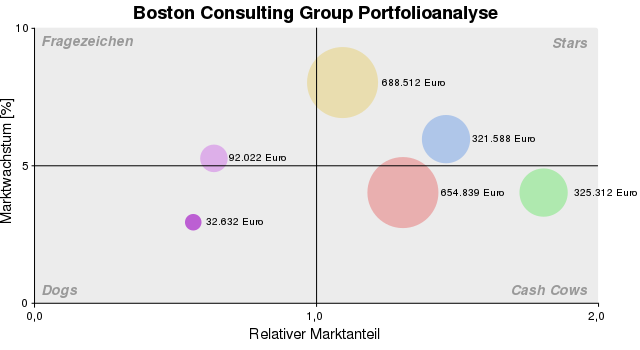Cash cow
Cashcow ([ 'kæʃ kau ]; English cash cow , Geldkuh , cash cow or milking cow ) is an anglicism for products , services or entire lines of business , as part of the core business significantly to the earnings of a company to contribute.
General
In the product life cycle , the cash cow products have the BCG matrix , according to the market stages of market maturity ( English marketability ), launch ( english introduction stage ), the market growth ( english growth stage ) and the market saturation ( English decline stage ) overcome and are in the maturity stage ( English maturity stage ). Their market growth is low, but their relative market share is high. Cash cows are often the main source of revenue of a company so that they in the organizational structure to the strategic business unit of a company are. They have a high relative market share with only low market growth. A distinction must be made in marketing between leading brands ( English power brands ), the flanking brands used to protect them ( English flanker brands ), cash cows and brands that will gain in importance in the future ( English future power brands ).
Business aspects
The cash cows with from sales redeem achieved contribution margin is always much higher than that necessary for her research and development costs . Your research and development payback period has ended or is about to expire. That is why they finance part of the research and development costs for other products or product innovations with their cash flow . This succeeds because their market volume and their sales revenues continue to increase in absolute terms; the incremental revenues but decline. Increasing market volume, in turn, can increase the market share of cash cows; cash cows are often market leaders due to their high market share . At the same time, sales activities and sales costs can be reduced because a high market share has already been achieved. Such products are also known as self-sellers because they get along practically without any advertising expenditure. These are mostly branded items that are protected with a trademark . In the pharmaceutical industry , their patent term is about to expire or has expired, so that generic products from price adjusters are competing.
Examples
Examples of cashcows include Aspirin , Nivea , Persil , Tempo or UHU , whose brand name has also established itself as a generic name for the respective purpose in the form of deonyms (for example, "Aspirin" - also in the USA - stands for headache tablets , Tempo for Paper handkerchiefs , eagle owl for all-purpose glue ). These products - also marketed internationally - are in competition with competing substitute goods .
Individual evidence
- ↑ Mario Pufahl: Vertriebscontrolling , 2014, p. 66
- ↑ Rainer HG Großklaus: Introducing New Products: From Idea to Market Success , 2008, p. 84
- ↑ David A. Aaker: Brand Portfolio Strategy , 2004, p. 23 ff.
- ↑ Gunnar Levknecht: Analysis approaches in strategic management , 2014, p. 12
- ↑ Mario Pufahl: Vertriebscontrolling , 2014, p. 66
- ↑ Burkhardt Röper: The abuse control against the background of the developments of the more recent competition theory. 1982, p. 140.
- ↑ David A. Aaker / Erich Joachimsthaler, Brand Leadership , 2000, o. P.
- ^ Anthony R. Gray, Studies in Economics and Business: Marketing , 2000, pp. 28 f.
